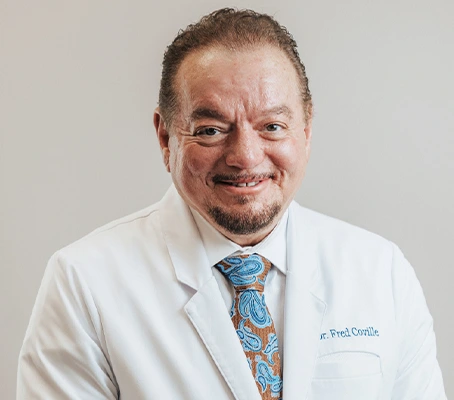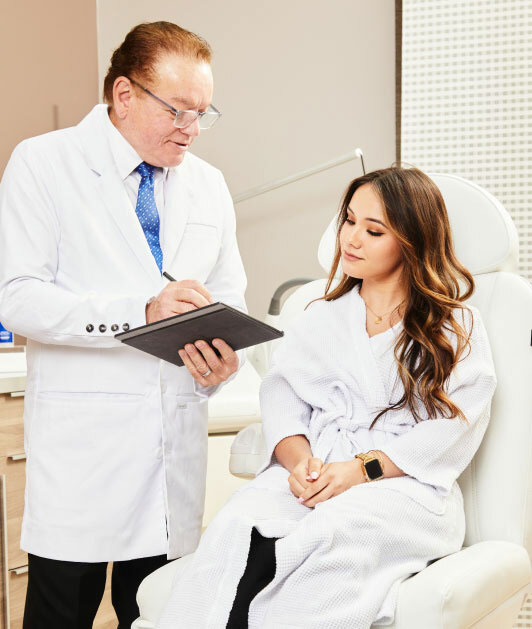- Select Language ▼
Cornerstone Plastic Surgery has partnered with Rejuvenessence to bring you an expert-led Weight Loss Program. Learn More on our partner’s website!
Rhinoplasty, commonly known as a nose job, is a surgical procedure that reshapes the nose to enhance facial harmony and improve nasal function. It can address a wide range of issues, including size, shape, proportion, and structural problems that cause breathing difficulties.
Dr. Fred Coville uses advanced techniques to customize each rhinoplasty to the patient’s unique facial features and aesthetic goals. Whether you’re seeking subtle refinements or more dramatic changes, Dr. Coville’s expertise ensures natural-looking results that complement your overall appearance. Patients across South Jersey and the Jersey Shore trust Dr. Coville for his exceptional skill and results.
Dr. Fred Coville performs rhinoplasties at private, fully accredited surgery centers on the Southern New Jersey Shore. The choice of the center will depend on the availability of operating room time, Dr. Coville’s schedule, and your timetable. This procedure is done on an outpatient basis.
Rhinoplasty usually takes 1-2 hours, though more complex procedures may take longer. The skin of the nose is separated from the supporting bone and cartilage, which is then sculpted to the desired shape. The skin is redraped over the new framework, and a splint is applied to help maintain the new shape. The surgery can be performed inside the nostrils or through an ‘open’ procedure with a small incision across the columella.
When considering a nose job, patients often face the decision between open and closed techniques, each with its advantages and considerations. Understanding the differences between these approaches is crucial for making an informed decision that aligns with individual needs and aesthetic goals.
Aspect |
Open Rhinoplasty |
Closed Rhinoplasty |
|---|---|---|
| Incision Location | External incision across the columella | All incisions made internally within the nostrils |
| Scarring | Small, visible scar on the columella | No visible external scars |
| Visibility | Direct visibility and access to nasal structures | Limited visibility and access |
| Precision | Allows for meticulous sculpting and reshaping, ideal for complex cases | Suitable for less complex adjustments, quicker recovery |
| Recovery | Longer due to more extensive surgical access | Shorter due to less invasive approach |
| Ideal For | Extensive reconstruction or revision cases | Minor adjustments, patients concerned about visible scarring |

Aspect |
Primary Rhinoplasty |
Revision Rhinoplasty |
Ethnic Rhinoplasty |
Non-Surgical Rhinoplasty |
|---|---|---|---|---|
| Surgical/Non-Surgical | Surgical | Surgical | Surgical | Non-Surgical |
| Concern Addressed | Improving the appearance of the nose | Addressing issues from a previous nose surgery | Tailoring the nose to match ethnic features | Making minor adjustments to the nose |
| Type of Incisions | Depends on the technique (open or closed) | Depends on the complexity of the revision | Depends on individual needs and desired outcome | Injectable fillers are used |
| Length of Surgery | Typically 1-2 hours | Longer than primary nose job | Similar to primary nose job | Short (usually less than an hour) |
| Recovery Time | 1-2 weeks for initial recovery | Longer than primary rhinoplasty | Similar to primary rhinoplasty | Minimal downtime |
| Scars | Incisions may result in minimal scarring | Additional surgery may lead to more visible scars | Similar to primary rhinoplasty | No visible scars |
| Anesthesia | General anesthesia | General anesthesia or local anesthesia | General anesthesia or local anesthesia | Local anesthesia or topical numbing |
| Post-Op Care | Follow surgeon’s instructions for wound care, nasal packing, and splint removal | Similar to primary nose job | Similar to primary nose job | Minimal post-procedure care required |
| Ideal Candidates | Individuals seeking to improve nasal aesthetics and function | Patients dissatisfied with previous nose job | Those looking to maintain ethnic identity | Individuals with minor nasal imperfections |
| Benefits | Improved nasal appearance and facial harmony | Correcting issues from previous surgery | Enhancing facial features while preserving ethnicity | Quick, non-invasive enhancement of nasal shape |
| Technique (Open or Closed) | Can be performed using either open or closed techniques | Typically requires an open technique | May involve open or closed technique | N/A |
Good communication between you and your surgeon is essential. Dr. Coville will discuss your goals, evaluate the structure of your nose and face, and explain the factors that can influence the procedure’s success. He will also cover the techniques, anesthesia, facility details, risks, costs, and any other options.
Preparation includes following instructions on eating, drinking, smoking, and medications. If you smoke, it’s crucial to stop at least 4-6 weeks before and after surgery to ensure proper healing. Be honest about your smoking habits, as it affects blood flow and healing. Arrange for someone to drive you home and assist you for a few days post-surgery.
The procedure can dramatically change your appearance closer to your ideal, improving self-confidence. However, it cannot change your looks completely or affect how others treat you. The best candidates are looking for improvement, not perfection, and are physically healthy, psychologically stable, and realistic.
Many surgeons, including Dr. Coville, prefer to only operate on teenage patients once they’ve completed their growth spurt, around 14-15 for girls and a bit later for boys. Dr. Coville will ensure that surgery is what the individual wants, not just their parents.
For the first 24 hours after surgery, your face will feel puffy, your nose may ache, and you may have a dull headache. Prescribed pain medication can control this. Plan to take it easy with your head elevated for the first few days. Swelling and bruising around your eyes will increase initially, peaking at 2-3 days. Cold compresses will help reduce swelling.
Most swelling and bruising should disappear within 3 weeks, although some subtle swelling may remain for several months. Some bleeding and stuffiness are common in the early days. Avoid blowing your nose for 2 weeks to allow the tissues to heal. Nasal packing, if used, will be removed after a few days. By the end of 1 week, all dressings, splints, and stitches should be removed.
When the swelling subsides, you can expect a better facial balance and an improved reflection. This enhancement often improves confidence and comfort in social, professional, and personal situations. Many patients find a nose job to be a valuable investment, wondering why they waited so long.
If you want to improve your nose’s appearance and are physically healthy, psychologically stable, and realistic in your expectations, you might be a good candidate for rhinoplasty. It’s crucial to have a thorough discussion with Dr. Coville to ensure that your goals align with what is surgically achievable. Contact our South Jersey office to schedule your consultation with Dr. Coville.
Choosing a well-qualified and experienced plastic surgeon like Dr. Coville minimizes risks, but complications can still occur. Potential risks include infection, bleeding, and minor complications like burst blood vessels. Dr. Coville will ensure you are well-informed about all risks and post-operative care requirements.
All patients are advised not to take drugs containing aspirin, ibuprofen, or ginkgo biloba for at least 10 days before their operation as these can alter the clotting of the blood. Just one tablet can affect your clotting for up to 2 weeks. Smoking affects your skin’s blood vessels and decreases the amount of vitamin C in your system. This makes both bleeding after the operation and the risk of skin dying more likely. Dr. Coville will insist you refrain from smoking for at least 6 weeks before and following surgery. Remember, you have absolutely nothing to gain by concealing a smoking habit from your surgeon.
After surgery, small burst blood vessels may appear as tiny red spots on the skin’s surface. Usually, these are minor but can, in some instances, be permanent. When rhinoplasty is performed from inside the nose, there is naturally no visible scarring. Yet, even when an ‘open’ technique is used, or when the procedure calls for the narrowing of flared nostrils, the small scars at the base of the nose are not usually visible. In about one case out of ten, a second minor procedure may be required, for example, to correct a slight deformity. These relatively rare problems are unpredictable and can happen even to patients in the hands of the most skilled surgeons.
Rhinoplasty costs can vary widely based on the complexity of the procedure and the specifics of each case. During your consultation, you will receive a detailed cost estimate tailored to your individual treatment plan.
Most private insurance policies do not cover purely cosmetic surgery. However, if the procedure is performed for reconstructive purposes, it may be wholly or partially covered. Check with your insurer and obtain payment authorization before any surgery.
Initial recovery takes about 1-2 weeks, with most swelling and bruising subsiding within 3 weeks. Full recovery and the final results can take several months to a year as residual swelling gradually resolves.
Post-operative pain is usually mild and can be managed with prescribed pain medications. Most patients report discomfort rather than severe pain, with feelings of stuffiness and congestion being common.
Rhinoplasty is typically recommended for patients who have completed their growth spurt, around age 14-15 for girls and slightly later for boys. It is essential to assess the individual’s maturity and ensure the decision is patient-driven.
Revision or secondary rhinoplasty, is performed to correct or improve the results of a previous nose surgery. It addresses issues such as unresolved functional problems or aesthetic concerns and can be more complex than a primary nose job.
Written By: Dr. Frederick Coville
Frederick A. Coville, M.D., Cornerstone Plastic Surgery’s Owner and Medical Director
Frederick A. Coville, M.D., Cornerstone Plastic Surgery’s Owner and Medical Director, has been an Aesthetic and Reconstructive Plastic Surgeon for over 25 years. He firmly believes each of us possesses an inner “Foundational Beauty.”
As a student of beauty all his life, he calls upon his naturally artistic eye and God-given talents as a surgeon to deliver the results you demand. Dr. Fred likes to say, “It’s my job to help you find Your Beautiful!”
Request your consultation and let
us create a custom experience for you
